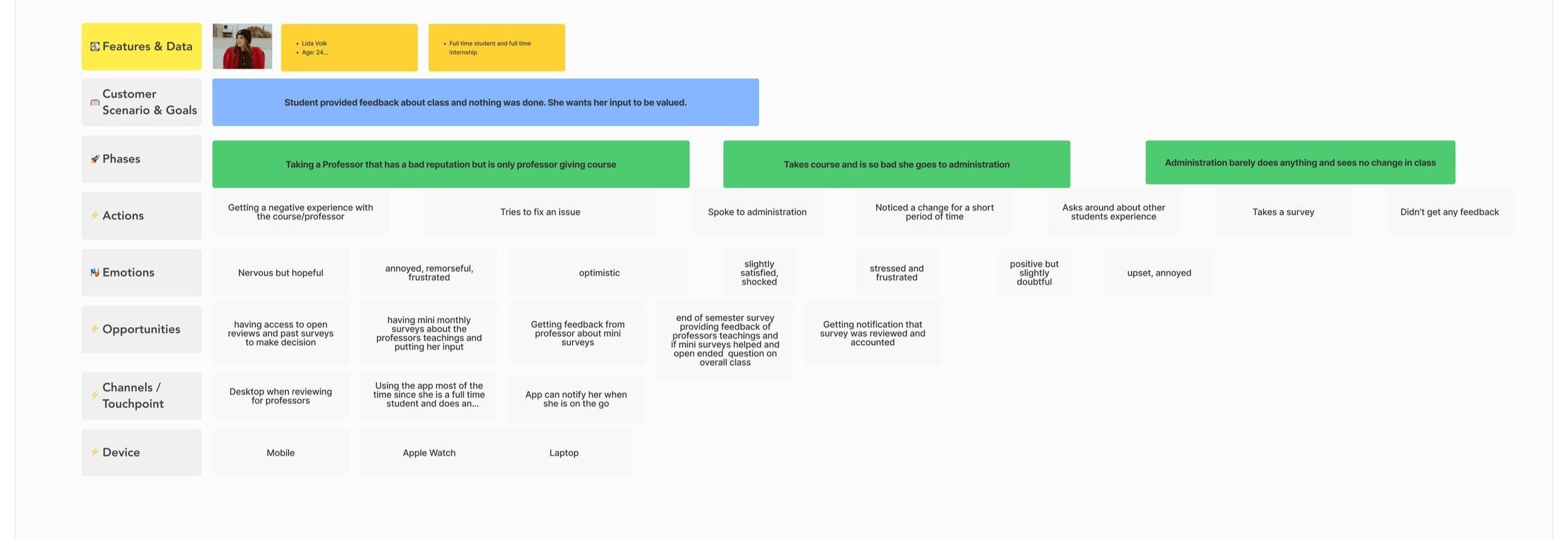
Class Ranked
-
Class Rank struggled with low student participation in end-of-semester surveys, limiting valuable course feedback. This case study explores the design of an intuitive app that increases engagement through non-financial incentives such as gamification, transparency, and community-building.
-
As a UX/ UI designer, I led the user testing and development from beginning to end and collaborated with my UX partner throughout the project's growth. We achieved our goal through research, design, and testing.
-
Lack of student participation in the ‘End of the semester’ Survey
No app for students to take survey
-
Design an easy aesthetically pleasing app
Create non-financial incentives for students to take the ‘End of the semester’ survey
Increase participation by 50%
Discover
We surveyed 13 people, and the results show that 69.2% agree that the ‘End of the Semester’ surveys does help, but when it came to taking the survey 61.5% rarely took them while 38.5 % regularly took them.
We also interviewed 7 people who are either current students or recent graduates and they had responded that the surveys we not useful because they as students didn’t see how it would benefit or affect them on the current course they were taking. These responses are known as ‘Painpoints’, the users' frustrations and difficulties.
Pain Points
Through user feedback and behavioral patterns, we identified several key frustrations students face with course evaluation surveys:
Lack of visibility or impact: Students don’t see how survey feedback affects their current semester or leads to meaningful changes.
No follow-through: The same issues persist semester after semester, leading to skepticism that surveys have any real effect.
No clear benefit to students: Filling out surveys feels like a one-sided request, offering no value or incentive for the student.
Too time-consuming: The surveys are often long, repetitive, and not user-friendly, leading to low engagement and rushed responses.
Define
Click to view
Persona
We created a user persona to build empathy with our audience. Lida Volk is an immigrant student pursuing higher education in the U.S. She struggles with a professor known for poor teaching, but must endure the course since it’s mandatory and the only option available.
Emotional Journey Map
Journey Map
Ideate
Problem
Students often feel unheard when stuck with difficult professors and lack motivation to complete long, end-of-term surveys—especially when their feedback doesn’t lead to visible change.
Solution
Designed an optional ‘Monthly Mini Survey’ so students could voice concerns during the semester, not just at the end.
Enabled survey progress saving to allow pausing and resuming the ‘End of Semester’ survey, reducing drop-off rates.
Added an ‘Open Review’ feature, unlocked after survey completion, for detailed, free-form feedback on courses and professors.
Introduced non-financial incentives to boost participation, including:
Extra credit
Early access to grades
Study guides and notes for future courses
Lo-Fi
For Classranked, we created lo-fi wireframes—basic, simple layouts that focus on where key elements like buttons and text go, without any colors or detailed visuals. These wireframes helped us quickly test the app’s structure and user flow, so we could make improvements early before adding design polish
Mid-Fi
Mid-fi wireframes added more detail to the basic layouts by showing better structure, spacing, and content placement, though still without final colors or images. This helped us get a clearer idea of how the app would look and feel, making it easier to gather feedback on usability and flow before moving on to high-fidelity designs.
While the main case study focuses on research, user flows, and problem-solving, I also explored the visual direction for Class Ranked. This includes the style tile, component library, and high-fidelity UI screens that bring the student experience to life with a clean, intuitive, and trustworthy interface.
Validate
Prototype
Usability Testing
Monthly Mini Survey: Tested by 10 users with an 88% success rate.
Continuing Survey & Open Review: Tested by 9 users with a 78% success rate.
Redeem and Review Flow: Tested by 10 users with a 70% success rate.
All flows were designed to be user-friendly and took less than one minute to complete on average.
Next Steps
According to feedback, we need to review a different color scheme and make it more appealing to the eye.
Offer different notification setting for the user.
Continue ideating on how to engage students into participating in the ‘End of the Semester’ Survey
Conclusion
User research revealed two key insights: students don’t participate in ‘End of Semester’ surveys because they see no immediate benefit and feel the University doesn’t listen to their concerns about courses or professors. Our design for the Class Ranked student app empowers students to share feedback in real time during the semester, giving them a stronger voice. Additionally, non-financial incentives and an auto-save feature encourage survey completion without adding cost to the University.
These features work together to increase student engagement and ensure more timely, actionable feedback for improving courses.










